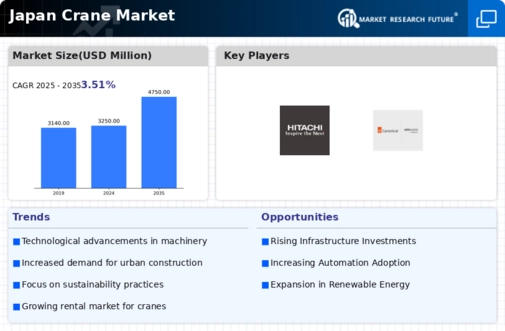Urbanization Trends
Japan's rapid urbanization is a significant factor influencing the crane market. As more people migrate to urban areas, the demand for residential and commercial buildings is increasing. This urban growth necessitates the use of cranes for construction projects, ranging from high-rise buildings to infrastructure improvements. Current estimates suggest that urban areas in Japan will see a population increase of approximately 10% by 2030, further driving the need for construction activities. Consequently, the crane market is likely to experience heightened demand as construction firms ramp up operations to accommodate this urban expansion.
Aging Construction Equipment
The aging construction equipment in Japan presents a compelling driver for the crane market. Many construction firms are currently operating with outdated machinery, which may not meet modern safety and efficiency standards. As a result, there is a growing need for replacement and upgrading of cranes. It is estimated that around 30% of cranes in use are over 15 years old, leading to increased maintenance costs and reduced productivity. Consequently, construction companies are likely to invest in new cranes that offer advanced technology and improved performance. This trend is expected to stimulate growth in the crane market as firms prioritize modernization to remain competitive.
Infrastructure Development Surge
The ongoing infrastructure development in Japan is a primary driver for the crane market. With the government investing heavily in transportation networks, urban development, and public facilities, the demand for cranes is expected to rise significantly. For instance, the Japanese government has allocated approximately $200 billion for infrastructure projects over the next five years. This investment is likely to create a robust demand for various types of cranes, including tower cranes and mobile cranes, as construction companies seek to enhance their operational efficiency. The crane market in Japan is poised to benefit from this surge, as construction activities increase across urban and rural areas alike.
Technological Integration in Construction
The integration of advanced technologies in construction processes is reshaping the crane market. Innovations such as automation, telematics, and smart cranes are becoming increasingly prevalent in Japan's construction sector. These technologies enhance operational efficiency, safety, and productivity, making modern cranes more appealing to construction companies. As firms seek to adopt these advancements, the demand for technologically advanced cranes is expected to rise. It is projected that the market for smart cranes could grow by 15% annually, reflecting the industry's shift towards more sophisticated equipment. This trend is likely to drive growth in the crane market as companies invest in cutting-edge solutions.
Rising Demand for Renewable Energy Projects
The shift towards renewable energy sources in Japan is driving the crane market. As the country aims to increase its reliance on solar, wind, and other renewable energy projects, the construction of related infrastructure is becoming more prevalent. This transition is likely to require specialized cranes for the installation of wind turbines and solar panels. Reports indicate that investments in renewable energy infrastructure could reach $50 billion by 2030, creating substantial opportunities for crane manufacturers. The crane market is expected to expand as companies seek to meet the demands of this evolving energy landscape.













Leave a Comment